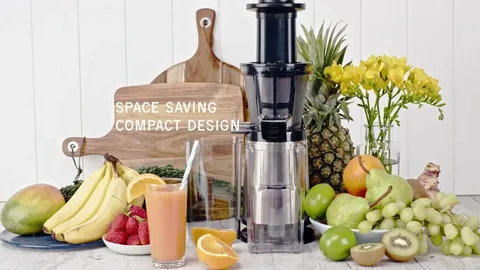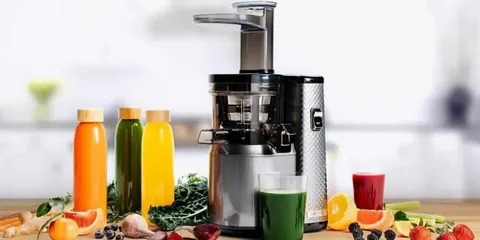A slow-juicer is the perfect kitchen appliance for anyone who wants to enjoy the most nutritious juice possible. This slow-press juicer uses a gentle cold-press method to extract the maximum amount of juice and vitamins from fruits, vegetables, and even leafy greens. The process takes longer than a traditional juice-extractor, but you can rest assured that every drop is packed with goodness. With a slow juicer, you can unlock the full potential of healthy ingredients and enjoy delicious and nutritious juice any time.
The Basics of Juicing
Juicing is a simple yet effective way to incorporate more fruits and vegetables into your daily diet. It involves extracting the natural liquids and nutrients from fresh produce, leaving behind the pulp. Doing this allows you to easily consume a concentrated dose of vitamins, minerals, and antioxidants as a refreshing beverage.
You’ll need a reliable juicing appliance like a slow-juicer to get started with juicing. Unlike traditional juicers that use high-speed blades to extract juice quickly, a slow-juicer operates at a slower speed. This gentle cold-press method ensures that the maximum amount of juice and nutrients are preserved, resulting in a more flavorful and nutritious drink.
When juicing, it’s important to choose a variety of fruits and vegetables to ensure a well-rounded blend of vitamins and minerals. Leafy greens like kale and spinach, citrus fruits like oranges and lemons, and vibrant berries like blueberries and strawberries are all excellent choices. Experiment with different combinations to discover your favourite flavours.
The Advantages of a Slow-Juicer
Slow-juicers offer several advantages over traditional juice-extractors, making them an excellent choice for health-conscious individuals. The slow-press method these juicers use ensures that the maximum amount of juice and nutrients are extracted from your fruits and vegetables. This means you get the most out of every ingredient, ensuring a flavorful and nutritious drink.
Another advantage of slow-juicers is their ability to handle a wide range of produce, including leafy greens like spinach and kale. These juicers have powerful motors and specialized gears to handle even the toughest ingredients, producing smooth and delicious juice. Slow-juicers also operate slower than traditional juicers, which means less heat and oxidation are produced during the juicing process.
This helps to preserve the natural enzymes and antioxidants in your juice, resulting in a fresher and more vibrant drink. Slow-juicers are typically quieter than traditional juicers, making them perfect for those early morning juice-making sessions when you don’t want to wake the whole house.
How a Slow Press Juicer Works
A slow-press juicer is a fascinating machinery that utilizes a unique mechanism to extract juice from fruits and vegetables. Unlike traditional juicers that rely on high-speed blades to pulverize produce, a slow-press juicer operates at a much lower speed. This slow and gentle process helps preserve the ingredients’ natural flavours, nutrients, and enzymes, resulting in superior-quality juice.
At the heart of a slow press juicer is a single auger or gear that slowly rotates and presses the fruits and vegetables against a mesh screen. This action effectively squeezes out the juice while leaving behind the fibrous pulp. By minimizing the amount of heat and oxidation produced during the juicing process, a slow-press juicer helps maintain the integrity of the nutrients and enzymes, ensuring you get the most out of your juice.
The slow and thorough extraction process of a slow-press juicer means you can extract more juice from the same amount of produce as traditional juicers. This maximizes the value of your ingredients and allows you to enjoy a higher yield of nutrient-rich juice.
Comparing Slow-Juicers to Other Types of Juicers
When it comes to juicers, there are several options available on the market. While slow-juicers are the show’s star, comparing them to other types of juicers is essential to understand their unique advantages. Firstly, slow-juicers excel in extracting juice from leafy greens like spinach and kale.
Their powerful motors and specialized gears make it a breeze to process these nutrient-packed ingredients, resulting in a smooth and vibrant juice. On the other hand, centrifugal juicers operate at high speeds and use blades to extract juice quickly. While they are faster, they tend to generate more heat and oxidation, which can affect the quality and nutritional value of the juice.
Masticating juicers, like slow-juicers, operate at a slow speed but use a different mechanism to extract the juice. They typically have an auger that grinds and squeezes the produce. While efficient, slow-juicers offer a better yield and preserve more nutrients due to their gentle cold-press method.
Tips for Using Your Slow-Juicer
Here are some helpful tips to make the most out of your slow-juicer experience:
- Prep your ingredients: Wash your fruits and vegetables thoroughly before juicing. Cut them into small pieces that easily fit into the juicer’s chute. Removing any tough stems or seeds will ensure a smoother juicing process.
- Alternate ingredients: To optimize the juicing efficiency, alternate between soft and hard ingredients. Start with softer items like leafy greens or citrus fruits, followed by harder ones like carrots or apples. This helps prevent clogging and allows the juicer to extract every last drop.
- Be patient: Remember, a slow-juicer operates at a slower speed than traditional juicers. Take your time with the process by simultaneously forcing too much produce into the chute. Take your time and let the juicer do its job, extracting juice with precision.
- Juice immediately: To enjoy the full nutritional benefits, consuming your juice immediately after juicing is best. The longer it sits, the more it oxidizes and loses nutrients. If you need to store it, transfer the juice to an airtight container and refrigerate for up to 24 hours.
- Clean promptly: Cleaning your slow-juicer right after use will save you time and effort. Disassemble the juicer and rinse the parts with warm water. Use a soft brush to remove any residue or pulp. Dry all parts thoroughly before reassembling.
By following these tips, you’ll be well on your way to creating delicious and nutrient-packed juices with your slow-juicer. Enjoy the journey to a healthier lifestyle, one sip at a time!
Recipes for Your Slow-Juicer
One of the best things about owning a slow-juicer is its endless possibilities for delicious and nutritious recipes. Here are a few ideas to get you started on your juicing journey:
- Green Goddess: Combine kale, spinach, cucumber, celery, and a squeeze of lemon for a refreshing and detoxifying green juice.
- Tropical Paradise: Blend pineapple, mango, coconut water, and a hint of ginger for a taste of the tropics.
- Berry Blast: Mix strawberries, blueberries, raspberries, and a splash of almond milk for a sweet and antioxidant-rich treat.
- Immunity Booster: Juice oranges, carrots, ginger, and turmeric to give your immune system a powerful boost.
- Energizing Beet: Combine beets, apples, carrots, and a dash of lemon for a vibrant and energizing juice.
Health Benefits of Juice Extractor
When it comes to juicing, a juice-extractor can offer many health benefits. By extracting the natural liquids and nutrients from fresh produce, juice-extractors provide a concentrated dose of vitamins, minerals, and antioxidants. These nutrients are essential for maintaining a healthy body and boosting overall well-being. One of the main health benefits of using a juice extractor is the ability to incorporate more fruits and vegetables into your diet easily.
Juicing allows you to consume a variety of produce conveniently and deliciously. It’s an excellent option for those who need help to meet their recommended daily servings of fruits and vegetables. Juice-extractors can help improve digestion. The juicing process removes the insoluble fibre from fruits and vegetables, making it easier for your body to absorb the nutrients.
This can promote better digestion and nutrient absorption, improving gut health. Another advantage of juice-extractors is their ability to support weight loss and maintenance. Juicing can be a low-calorie and nutrient-dense option for those looking to shed pounds or maintain a healthy weight. Replacing high-calorie beverages with fresh juices can reduce your overall calorie intake while still nourishing your body.
Maintenance and Cleaning Of Your Slow-Juicer
Keeping your slow-juicer clean and well-maintained is crucial for optimal performance and longevity. After all, you want to continue enjoying the goodness of every drop for years to come. Luckily, maintaining and cleaning your slow-juicer is a breeze. Consult the instruction manual that came with your specific slow-juicer model. This will provide you with detailed guidance on the cleaning process. Most slow-juicers have dishwasher-safe parts, so you can disassemble them and place them in the dishwasher for convenient cleaning.
However, double-checking the manual is always a good idea to avoid any potential mishaps. If your slow-juicer is not dishwasher safe, there is no need to worry. Cleaning it by hand is just as easy. Disassemble the juicer and rinse the parts with warm water immediately after juicing. Use a soft brush or sponge to remove any residue or pulp that may be stuck. A mixture of water and mild dish soap can be used for stubborn residue.
Dry thoroughly before reassembling the juicer once all the parts are clean. This helps prevent any mould or mildew from forming. A soft cloth or towel can be used to wipe down the parts. It’s important to note that you should never use abrasive materials or harsh chemicals on your slow-juicer, as this can damage the components. Make it a habit to clean your slow-juicer after each use. This will keep your juicer in optimal condition and ensure that every batch of juice you make is as fresh and delicious as possible.
FAQ’s
Q: Are slow-juicers difficult to clean?
A: Not at all! Most slow-juicers have dishwasher-safe parts, making clean-up a breeze. Disassemble and place the parts in the dishwasher. Hand-washing with warm water and mild dish soap will do the trick for non-dishwasher-safe juicers.
Q: Can I juice leafy greens with a slow juicer?
A: Absolutely! Slow juicers are specifically designed to handle leafy greens like kale and spinach. Their powerful motors and specialized gears can extract every drop of juice from these nutrient-packed ingredients.
Q: Can I store juice made with a slow-juicer?
A: Consuming your juice immediately after juicing is best to retain the maximum nutritional benefits. However, if you need to store it, transfer the juice to an airtight container and refrigerate for up to 24 hours.
Q: Do slow-juicers make a lot of noise?
A: No, slow-juicers are typically quieter than traditional juicers. This makes them perfect for early morning juicing sessions when you don’t want to wake the whole house.
Q: Can I juice frozen fruits with a slow-juicer?
A: It’s best to thaw frozen fruits before juicing them with a slow-juicer. This ensures a smoother and more efficient juicing process.
Conclusion
In a world where health and wellness are top priorities, a slow-juicer is the perfect kitchen companion. It allows you to unlock the full potential of your fruits, vegetables, and leafy greens, ensuring that every drop of juice is packed with goodness. With its gentle cold-press method, a slow-juicer preserves the maximum amount of nutrients, resulting in a more flavorful and nutritious drink. Plus, it’s versatile, quiet, and easy to clean. So, whether you’re a seasoned juicer or just starting your journey to a healthier lifestyle, a slow-juicer is a must-have appliance for every kitchen. Cheers to better health, one delicious sip at a time!




